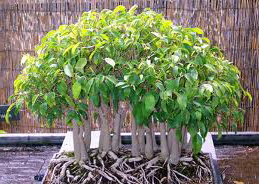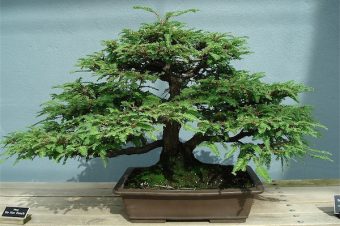More Than a Plant: The Living Legacy of Bonsai
Story by Penny Swift

The word bonsai is Chinese for “trees in trays”, which makes it rather strange that the art of bonsai is primarily associated with Japan. But this is purely because it is the Japanese who initially perfected the art of deliberately dwarfing trees.The picture above shows a stunning little bonsai forest.
The principal idea of bonsai is to grow a tree on a tiny scale, so that it eventually looks just like the tree that would grow in nature… to its full size. In other words, it should be a perfect miniature of what you would find in your garden, or in a forest.
Unlike growing trees for shade or even as a source of material for construction or furniture-making, trees grown on this scale are purely decorative … a little living ornament. Bonsai is a living craft and it is a long-term craft, since it takes many years for trees to get to dwarf-sized maturity.
Origins of the Art of Bonsai
Bonsai is a living craft and the art of bonsai dates back thousands of years, and there are believed to be living bonsai trees that are as old as 500 years.
One of the earliest bonsai trees on record in Japan dates to the years between 603 and 839 when several Japanese diplomatic missions went to China. Japan’s Shosoin, a veritable treasure house dating to the 8th century, has an amazing example of this kind of art, although the trees are sculpted rather than living and defines that bonsai is a living art.
The Best Trees for Bonsai
Generally it is accepted that the most suitable trees for bonsai are oaks, maples, crab apple and plum trees, as well as acacias, some of the Ficus species, schotias and wild olives. Some evergreens are also popular, including azaleas, cotoneasters and pyracanthas. Conifers also make excellent subjects to create “bonsai is a living craft”.
Here Is An Extract From The Rocky Mountain Bonsai Society on Re-potting a Bonsai
Why Repot?
Repotting or transplanting bonsai is always stressful for the tree, which is why it’s not generally a good idea to repot a sick tree; it may likely die. So we need to have a good reason to do so. Here are several reasons why you may want to consider repotting a bonsai:
1) Loss of water percolation. When you see lack of percolation (i.e. water standing on the surface of the soil for a prolonged time when you water), the first step should be to clean the surface of the soil of decomposing organic fertilizer, moss and surface roots. This should be done every two to three years, or when there is obvious lack of percolation. When cleaning the surface of the soil, you need to take it down to where you see friable soil (i.e. the granular particles of the soil). Then you can backfill the surface with new soil and add fresh top dressing. If you continue to dig down and find no friable soil particles, then the tree probably needs to be completely
repotted.2) Decomposing soil. This is actually similar to #1. If the tree has been in a soil mix for some time, the soil particles have broken down and the mix is no longer draining properly, that is generally a signal to repot.
3) Replacing nursery or native soil. If you obtain a tree from a nursery there is a very good possibility that it is not growing in soil that is suitable for bonsai. Nurseries generally do not want to spend more time and money than they have to on watering, so their trees are likely to be growing in very dense mucky soil that is not conducive to the development of fine roots and may be conducive to root rot. The same may be true for field-collected trees. In the case of nursery stock, if the tree is healthy it is a good idea to get it into better
draining bonsai mix as soon as possible, but see cautions below about how much soil to remove.4) Change of style or planting inclination. If the styling objectives for the tree indicate that it should be placed at a different angle or orientation with respect to the viewer, this can also be a reason to repot. Change of style can obviously also suggest a different container shape or size. MORE…




4 Responses
DIY Bonsai 3 Ideas - Crafting DIY
[…] Bonsai […]
DIY Bonsai - Crafting DIY
[…] Bonsai […]
Janek
Hi, Watering should be done regularly but it should relate to the bonsai species’ requirement for dry, moist, or wet soil. Tropical bonsai info can be found here: Indoor_bonsai
Splash Log Level 2 Again
I have a inexpensive “tropical” bonsai tree I got from wal-mart for about 10 bucks, It has lengthy, thin grassy leaves coming off it plus it happens to be about 20″, how frequently could I water it? Should I water it less considering it’s a “tropical” tree?